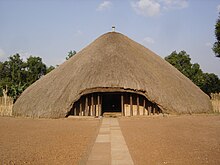Kasubi Tombs
| Kasubi Tombs | |
|---|---|
| Name as inscribed on the World Heritage List | |

The Kaaubi Tombs in 2007
|
|
| Location | Uganda |
| Type | Cultural |
| Criteria | i, iii, iv, vi |
| Reference | 1022 |
| UNESCO region | Africa |
| Coordinates | 0°19′45″N 32°33′12″E / 0.32917°N 32.55333°E |
| Inscription history | |
| Inscription | 2001 (25th Session) |
| Endangered | 2010–present |
The Kasubi Tombs in Kampala, Uganda, is the site of the burial grounds for four kabakas (kings of Buganda) and other members of the Baganda royal family. As a result, the site remains an important spiritual and political site for the Ganda people, as well as an important example of traditional architecture. It became a UNESCO World Heritage Site in December 2001, when it was described as "one of the most remarkable buildings using purely vegetal materials in the entire region of sub-Saharan Africa".
Some of the major buildings there were almost completely destroyed by a fire in March 2010, the cause of which is under investigation. As a result, in July 2010 it was included in the list of World Heritage Sites in Danger.
The Buganda Kingdom has vowed to rebuild the tombs of their kings and President Museveni said the national government of Uganda would assist in the restoration of the site. Reconstruction started in 2014, funded by the government of Japan.
The World Heritage Site comprises around 26 hectares (64 acres) on the Kasubi hill in the city of Kampala, about 5 kilometres (3.1 mi) northwest of the city centre. Most of the site is open agricultural land that is farmed using traditional techniques. One corner contains a royal palace built in 1882 by Muteesa I, the 35th Kabaka of Buganda, to replace a palace built by his built by his father, Ssuuna II in 1820. The new palace became a royal burial ground on his death in 1884. The site is one of 31 royal tombs across the Buganda kingdom since the kingdom was founded in the 13th century. Traditionally, the body of the deceased king was buried in one place, with a separate shrine for the deceased king's jawbone, believed to contain his soul. Unusually, in a break from tradition, the site in Kampala contains the royal tombs of four Kabakas of Buganda:
Descendants of these four Kabakas are buried elsewhere on the site.
The border of the ceremonial site were established in 1882 on Kasubi Hill, also known as the Ssekabaka's Tombs. The borders are still marked with bark cloth trees (Ficus natalensis), which have protected it from the low-rise residential development that now surround the site on all sides. The main ceremonial area is located to the northwest of the wider site. A gatehouse (Bujjabukula) leads to a small courtyard and the drum house (Ndoga-Obukaba) which houses the royal drums, and then to a second main circular courtyard (Olugya) located on the hilltop, surrounded by a reed fence.
...
Wikipedia
